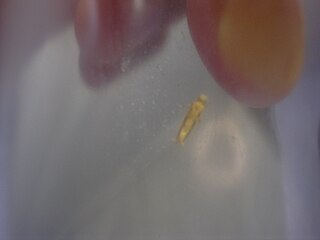
The light brown apple moth is a leafroller moth belonging to the lepidopteran family Tortricidae.
The Cosmopterigidae are a family of insects in the order Lepidoptera. These are small moths with narrow wings whose tiny larvae feed internally on the leaves, seeds and stems of their host plants. About 1500 species are described. The taxonomic family is most diverse in the Australian and Pacific region with about 780 species.

Spoladea recurvalis, the beet webworm moth or Hawaiian beet webworm moth, is a species of moth of the family Crambidae. It is found worldwide, but mainly in the tropics.

Anatrachyntis is a genus of moths in the family Cosmopterigidae. Some authors include it in Pyroderces.

Lantanophaga pusillidactyla, the lantana plume moth, is a moth of the family Pterophoridae. It is native to the southern United States, Mexico, the Caribbean, and South America. It was introduced to Australia accidentally in 1936 and is now found from Sydney to Cairns along the coast. It has also been introduced to Hawaii in 1902, Pohnpei in 1948, and Palau in 1960 for biological control. It has since been recorded from Yap in 1987–1988 and is now distributed on all islands of the Mariana and Caroline Islands where the host plant is found, except Aguijan.
Anatrachyntis incertulella, the pandanus flower moth, is a small cosmet moth species. It belongs to subfamily Cosmopteriginae. This was the first "micromoth" species to be described from Hawaiʻi. The type specimens were collected there by the 1820s Beechey expedition and described by the English entomologist Francis Walker in 1864; they are now in the British Museum of Natural History.
Anatrachyntis rileyi, the pink cornworm, pink bud moth or pink scavenger, is a species of moth of the family Cosmopterigidae, the cosmet moths. It was first described by Lord Walsingham in 1882 from the southern United States, but it is probably an introduction to North America. It is found in much of the warm or tropical areas of the world, including northern Australia, the Galápagos Islands, Hawaii, the Antilles, South America and Mauritius.

Erechthias minuscula, the erechthias clothes moth, is a moth of the family Tineidae. It was first described by Lord Walsingham in 1897. It is widespread and has been recorded from Africa, Sri Lanka, Java, Australia, the Caroline Islands, Fiji, Samoa, the Marquesas, the West Indies, Hawaii and Florida.

Anatrachyntis simplex is a moth in the family Cosmopterigidae. It is found on Egypt, La Réunion, Gambia and the United Arab Emirates, Cyprus, Morocco, Portugal, Spain, India and China. It is recorded infrequently in the United Kingdom through accidental importation in pomegranates.
Anatrachyntis coridophaga is a moth in the family Cosmopterigidae. It is found in Egypt and Libya.
Ithome edax is a moth in the family Cosmopterigidae. It was described by Ronald W. Hodges in 1962. It is found in North America, where it has been recorded from Texas.
Ithome lassula is a moth in the family Cosmopterigidae. It was described by Ronald W. Hodges in 1962. It is found in North America, where it has been recorded from Florida. It was introduced into Australia by accident, where it is now found in Queensland.
Periploca atrata, the juniper cone moth, is a moth in the family Cosmopterigidae. It was described by Ronald W. Hodges in 1962. It is found in the United States, where it has been recorded from Arizona and California.
Periploca cata is a moth in the family Cosmopterigidae. It was described by Ronald W. Hodges in 1962. It is found in North America, where it has been recorded from Illinois and Arkansas.
Periploca funebris is a moth in the family Cosmopterigidae. It was first described by Ronald W. Hodges in 1962. It is found in North America, where it has been recorded from Arizona and California.
Periploca mimula is a moth in the family Cosmopterigidae. It was described by Ronald W. Hodges in 1962. It is found in North America, where it has been recorded from Arizona, Tennessee, Arkansas, Washington, Texas, and New Mexico.
Periploca laeta is a moth in the family Cosmopterigidae. It was described by Ronald W. Hodges in 1962. It is found in North America, where it has been recorded from Florida, Arizona, Illinois, Ohio, Quebec and West Virginia.
Stilbosis lonchocarpella is a moth in the family Cosmopterigidae. It was described by August Busck in 1934. It is found in Cuba and mainland North America, where it has been recorded from Florida.

Walshia miscecolorella, the sweetclover root borer moth, is a moth in the family Cosmopterigidae. It was described by Vactor Tousey Chambers in 1875. It is found in North America, where it has been recorded from southern Canada south to Florida and Texas.
Walshia floridensis is a moth in the family Cosmopterigidae. It was described by Ronald W. Hodges in 1978. It is found in North America, where it has been recorded from Florida.







